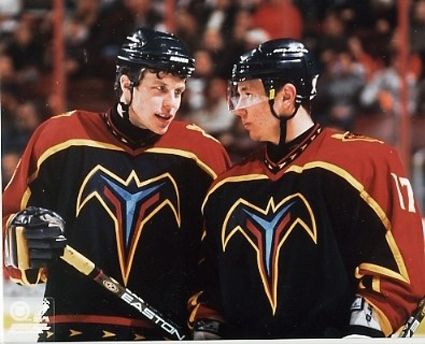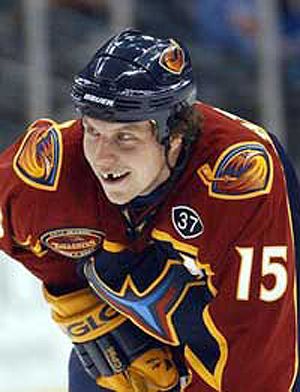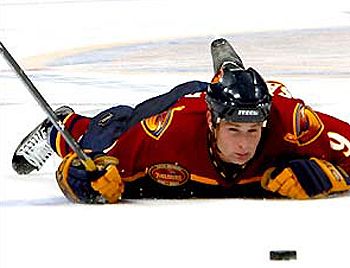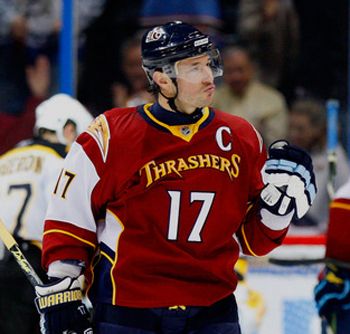Wednesday, June 1, 2011
2003-04 Atlanta Thrashers Dany Heatley Jersey
With yesterday's news that the Atlanta Thrashers ownership group has agreed to sell the Thrashers to a group based in Winnipeg, Manitoba who will relocate the team, the second era of NHL hockey in Atlanta has come to an end.
Following the Atlanta Flames move to Calgary in 1980, Atlanta was without a team of any kind until the IHL expanded in the form of the Atlanta Knights in 1992. The club only lasted four seasons before also relocating to Canada, this time to Quebec City.
Three seasons later, as part of the NHL expansion of 1998-2000, the Thrashers began play in the 1999-00 season after being granted a franchise back in the summer of 1997. On February 16, 1998 the club's original owner Ted Turner announced his choice of the name "Atlanta Thrashers", inspired by the state bird of Georgia, the Brown Thrasher.
The Thrashers home jersey was debuted on March 27th, 1999 at the nearby Olympic Park and their unconventional road jersey was revealed before a preseason game on September 19th of the same year.
Atlanta played their first official game no October 2, 1999 in front of a packed Phillips Arena, as 18,545 saw them fall 4-1 to the New Jersey Devils. led the inaugural season in scoring with 23 goals and 50 points as the Thrashers finished a distant last in points that season.
Perhaps the highlight of the Thrashers run in Atlanta was wining the draft lottery on April 10, 2001 which allowed them to select Russian Ilya Kovalchuk with the first overall pick of the 2001 NHL Entry Draft. Following the season, Dany Heatley, picked second overall during the previous year's draft, was named the winner of the Calder Trophy as the league's best rookie, edging out Kovalchuk.
Heatley and Kovalchuk
In February of 2003, Heatley was named the MVP of the NHL All-Star Game after scoring four goals and an assist on the day.
Tragedy struck in September when Heatley, who had led the club in scoring the previous two seasons lost control of his Ferrari and slammed into a wall. Teammate Dan Snyder died from his injuries six days later, while Heatley was limited to just 31 games after recovering from his broken jaw and torn knee ligaments.
Heatley returns to the ice with the Dan Snyder Memorial patch on his jersey
Those 31 games were Heatley's last in Atlanta, as he requested a trade out of Atlanta in hopes of leaving the reminders of the accident behind him. A trade brought Slovak Marian Hossa to the Thrashers for the 2005-06 season. Kovalchuk led the club with new franchise records for goals (52) and points (98), followed by Marc Savard (97) and Hossa (92). Still, the team missed the playoffs yet again, for the sixth season in a row and Savard departed as a free agent.
Marc Savard
In 2006-07, Hossa became the first Thrasher to score 100 points and the team finally qualified for the playoffs, only to be blitzed by the New York Rangers, who swept them in four straight while outscoring them 17-6.
Any progress made in 2006-07 was lost in 2007-08. The team began 0-6 and fired their coach of the past three seasons Bob Hartley. Later, when Hossa would not resign with the team, he was dealt to the Pittsburgh Penguins. In the end, the Thrashers not only missed the playoffs, but sank to 14th in the conference out of 15.
After two more seasons of not making the playoffs coach John Anderson's contract was not renewed and the Thrashers fans had to endure the loss of superstar Kovalchuk via trade when he, just like Hossa, was not interested in continuing to play for a franchise in the deep south that gave him no foreseeable chance to win a championship, much less qualify for the playoffs.
During this most recent season the Thrashers, led by their fourth coach in 11 seasons, finished 13 points out of the playoffs and showing no improvement, completing the schedule with less points than the season before despite an infusion of players via trade from the salary cap distressed Stanley Cup champion Chicago Blackhawks.
The Thrashers finished the year 28th in league attendance, averaging 13,469 fans, which was only 72.6% of capacity and less than two European club teams.
Throughout all the team's recent struggles on the ice, ownership was also historically an unsettled situation. After four seasons of ownership by media giant Time Warner, the team was sold prior to the 2003-04 season to an ownership group consisting of eight members, who purchased the club just eight days before Heatley's crash which killed Snyder.
In January of this year, the ownership group, which had been in turmoil, having been involved in legal proceedings brought by one of their own members, claimed losses of $130 million over the last six years and were looking to sell the team. When no one interested in buying the club with the intent on keeping it in Atlanta stepped forward, a sale was agreed to yesterday which will involve the club relocating to Winnipeg, who had lost their original Jets franchise in 1996.
Today's featured jersey is a 2003-04 Atlanta Thrashers Dany Heatley jersey, emblematic of the low point in Thrashers history, as it is from the season Heatley lost control of his Ferrari and crashed, killing teammate Snyder who is memorialized on the jersey with the #37 patch.
The Thrashers had an unconventional approach to their sweaters over their time in the NHL, which began with the very first season. WIth NHL rules in place not allowing new clubs to introduce an alternate sweater in their first three seasons, Atlanta did an end around the rules and made their original road sweaters in the style of an alternate, using their secondary logo as the primary logo on their dark sweaters from day one.
When their first alternate jersey arrived, it was instantly one of the worst jerseys we have ever seen, done in light blue with white numbers trimmed in yellow, a perfectly good color combination for a child's room, but not a professional sports club. Even worse, the jerseys had a single navy blue stripe down only the left arm, with "ATLANTA" running vertically down the sleeve, which created a jarring an unattractive look. That jersey survived as the dark sweater when the original road jersey was dropped in 2006-07.
The change to the new Reebok Edge jerseys only made matters worse, as the Thrashers distinctive winged sleeve striping on the white jerseys gave way to a mess of a jersey with additional piping and messy sleeves while the light blue jerseys became even worse with the navy blue arm stripe now changing widths as it travelled from the neck to the wrist.
A new alternate arrived on the scene in 2008 and was roundly criticized for it's football jersey styling, as rather than a team logo on the front, it controversially had a smallish Thrashers word mark over the player's number, which was prominently featured on the center of the chest where the team logo normally would reside. An enlarged Thrashers head on each sleeve acted almost as striping while the white areas on the sleeves stopped halfway down just after suddenly, and unexplainably wrapping around the arms.
Counting the six the change to the Reebok versions of their jerseys, the Thrashers had six jerseys during their run in Atlanta, four of which were plain awful.
Today's video section begins with the drafting of Ilya Kovalchuk in 2001, which should have sent the club on it's way to playoff success, but for various reasons did not.
Here is a compilation of Kovalchuk highlights, which also doubles as a Thrashers jersey retrospective.
With the team now relocating, and never having won a playoff game in it's history, this will now remain as the greatest moment in team history.
Labels:
Atlanta Thrashers,
Heatley
Subscribe to:
Post Comments (Atom)





















No comments:
Post a Comment
We welcome and encourage genuine comments and corrections from our readers. Please no spam. It will not be approved and never seen.